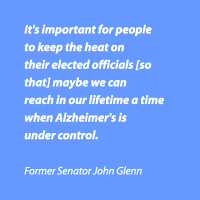Heavy Smoking and Alzheimer's
If the risks of heart disease and cancer aren't troubling enough, newly published research showing that heavy smoking in middle age more than doubles the risk of Alzheimer's disease might motivate some smokers to stop. This finding emerged from a study that followed more than 21,000 middle-aged men and women for 23 years. It showed that individuals who smoked two packs or more of cigarettes per day had a 114 percent greater risk of dementia than non-smokers; those who smoked between one to two packs a day had a 44 percent increased risk and those who smoked half to one pack daily had a 37 percent increased risk. Non-smoking middle-aged people in the study who identified themselves as former smokers didn't appear to have an increased risk of later dementia. The study's principal investigator suggested that smoking might increase the risk of dementia by narrowing blood vessels in the brain, and added that oxidative stress and inflammation promoted by cigarette smoke may also damage the brain, eventually leading to dementia. Researchers from Finland, Sweden and the Kaiser Permanente Health Plan reported the overall findings, which were published online October 25, 2010 by the Archives of Internal Medicine.
My take? In addition to the risk of lung cancer and emphysema, tobacco use raises risk of bladder cancer, cancers of the head and neck and leukemia. Smoking is especially dangerous if you are diabetic, take birth control pills or have any heart or circulatory problems, respiratory disease, urinary or prostate trouble, digestive disorders, a family history of cancer or increased risk of cancer for any reason, high blood pressure, seizure disorder or a family history of coronary heart disease. If none of that worries you, I'm not sure the risk of Alzheimer's will. But according to this study, it should.
Remember When...
advertisement
|
Lifestyle Changes Could Cut Colon Cancer by 23%
Five simple healthy habits could do the trick, according to a newly published study from Denmark. Researchers there reviewed data on more than 55,000 adults age 50-64 who were followed for 10 years. The lifestyle factors that appear to be protective include 30 minutes per day of physical activity, no more than seven alcoholic drinks per week for women and no more than 14 for men, not smoking, a healthy diet and a waist circumference below 88 cm (just under 35 inches) for women and 102 cm (40 inches) for men. Adhering to even one of the recommendations could have prevented 13 percent of colon cancers, the researchers calculated; following all five would have reduced colon cancer cases by 23 percent. On entering the study, participants answered questions about social factors, health status, reproductive factors and lifestyle habits. They also filled out a food frequency questionnaire developed to assess average intake over a year. The study was published online on October 26, 2010 at www.bmj.com.
Are You Eating Enough Fruit?
Fruit provides many key nutrients necessary for optimum health. If you aren't able to include fruit in your diet every day, consider filling the nutritional gap with a health-protective Antioxidant and Multivitamin Formula like the one available at Dr. Weil's Vitamin Advisor. Learn more - visit today and if you decide to purchase our supplements,save up to 25%.
Walk Away from Breast Cancer
…and make that a brisk walk. Researchers from Harvard reviewed data from more than 95,000 women who were followed for 20 years. Conclusion: an hour or more of brisk walking daily (or an equivalent activity) made the women 15 percent less likely to develop breast cancer than those who walked less than an hour a week. The exercise seemed to make the difference even after the potential influences of drinking alcohol and excess weight were taken into account. Brisk walking outscored swimming, hiking or jogging in terms of protectiveness. The definition of brisk, according to the researchers: between three to four miles per hour, a pace at which it's difficult to carry on a conversation. While earlier research has shown that exercise might be protective against breast cancer because it reduces levels of estrogen in the blood, this study found that exercise reduced the risk of breast cancers that aren't influenced by estrogen. It was published in the October 25, 2010 issue of the Archives of Internal Medicine.
Worried About Breast Cancer?
From a healthy diet to regular exercise, Dr. Weil’s Optimum Health Plan provides information and guidance in times of health and sickness. Visit today, see if our plan is right for you and get a free recipe!
Sponsor
Take Your Health in Your Hands
Preventive health is more than just being aware of potential diseases and injuries, it means taking an active role in your own well-being. Dr. Weil's Vitamin Advisor is a great way to start giving back to yourself. A few minutes are all it takes to learn what vitamins and supplements may benefit your lifestyle. Visit Dr. Weil's Vitamin Advisortoday: it is free, informative and helps provide the tools you need to practice preventive health.
What's New
Weil on Wellness at Miraval
Jan 30 - Feb 2, 2011 in Tucson, Arizona
Stress, and how we deal with stress, has a direct effect on our nutrition and diet. When under stress, there is a greater potential to make unhealthy eating decisions that may include such responses as emotional eating, mindless munching and crash diets. Dr. Weil's ground-breaking new program, Weil on Wellness at Miraval Resort and Spa, dedicates over thirty years of experience to uncovering the negative responses that occur when dealing with stress and how to make significant changes to these coping mechanisms for overall health and wellness. Book now by calling 800.232.3969.
8th Annual Nutrition & Health Conference
May 8-11, 2011 in San Francisco, California
Save the date! Expanding on the growing success of previous Nutrition and Health conferences, the 8th annual meeting, co-directed by Dr. Andrew Weil, will assemble an outstanding faculty of internationally-known scientific researchers, skilled clinicians, innovative chefs and best-selling authors whose work focuses on the interface between nutrition and healthful living. For registration information: www.nutritionandhealthconf.org
Follow Dr. Weil on Social Media:
Join Dr. Weil on Facebook, Twitter, and Dr. Weil's Daily Health Tips Blog.
Dr. Weil's Videos
Find a wide variety of videos from Dr. Weil on these video channels: YouTube and Vimeo.





